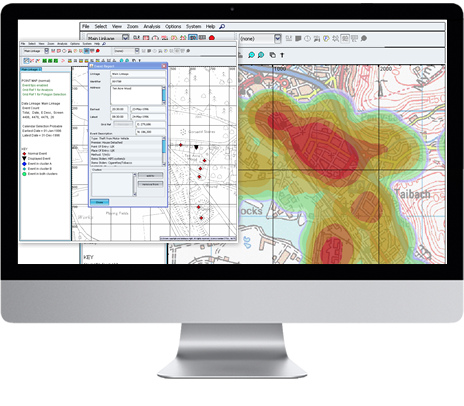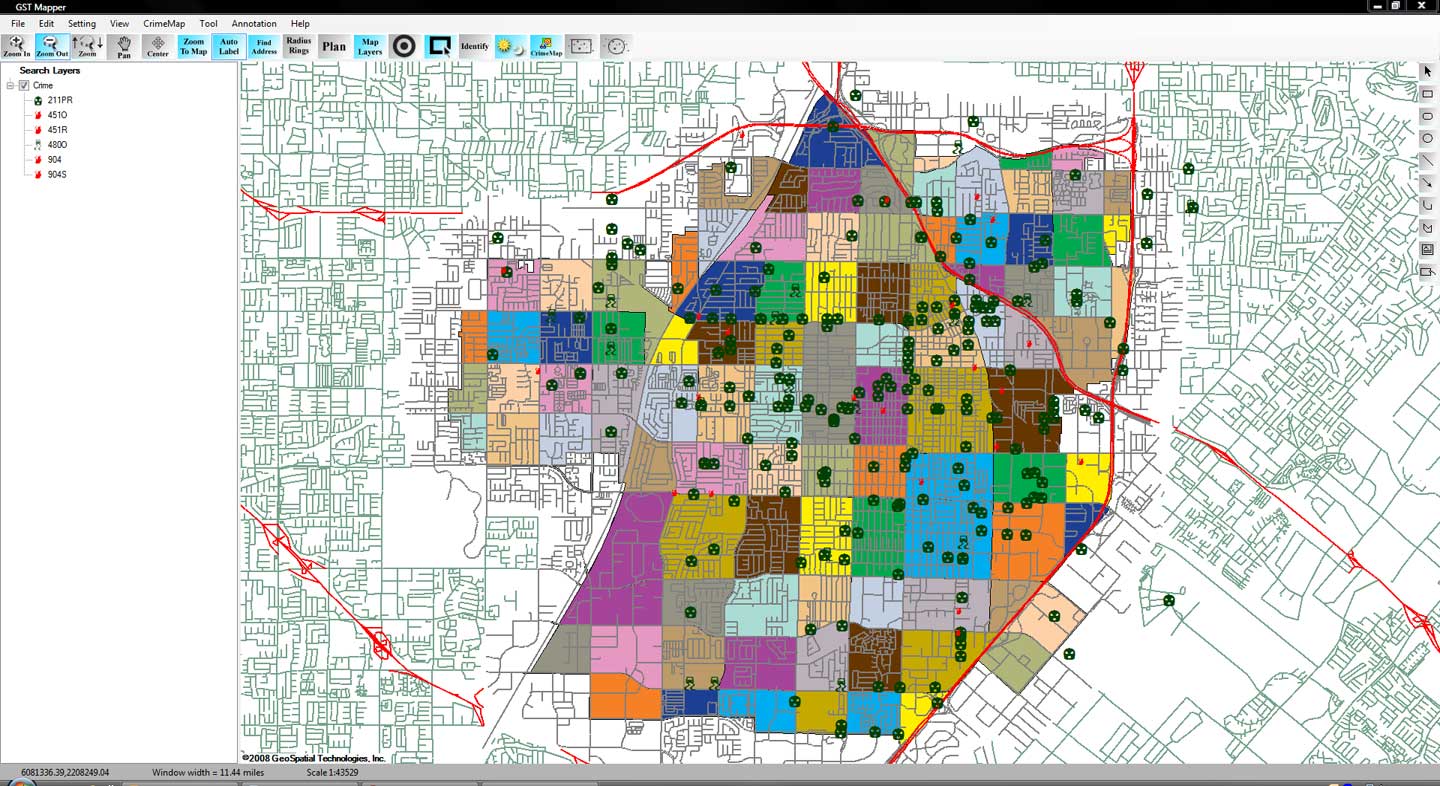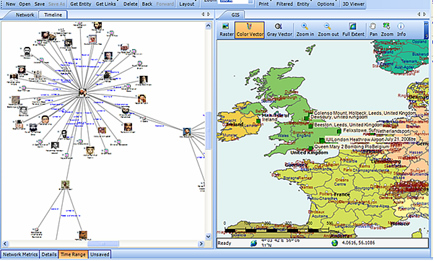
By Tyler Wood, Operations Manager at Crime Tech Solutions.
One of the many functions crime analysis performs is the identification of “hot spots”, or geographical areas that seem to be hubs for criminal activity. Identifying these hot spots through best practices in geospatial crime mapping allows law enforcement to focus their efforts in areas that need them most. The trouble that law enforcement and crime analysts have encountered is displacement – the fact that once a hot spot is “cleared”, crime seems to pop up again in a different location. The good news is that the displacement is never 100%, so policing hot spots is important – it’s just not a magic bullet.
To solve this problem, a team at Rutgers University’s School of Criminal Justice set out to develop new methodologies that would result in peaceful outcomes that are built to last instead of merely temporary.
The difference between the old approach and the new approach is stark. Where police and analysts used to focus solely on geographical concentration of crimes, Risk Terrain Modeling examines the factors that contribute to such dense concentrations to begin with. Rutgers team have identified several characteristics of any given geographical location which may attract or generate crime. Their technology takes these characteristics, which include socioeconomic data, physical layout, types of local businesses, etc… and uses them to calculate the likelihood crime occurring in the area. This allows law enforcement to be proactive in the prevention of crime in these areas.

The technique seems to be highly effective. After a trial run in New Haven, CT, police were able to identify sixteen “statistically significant risk factors that underlie violent crime occurrences.” A high percentage of violent crime in New Haven during the test period occurred in locations already identified by the concept of risk terrain modeling. Though the technology is still new, it is clearly showing impressive results already.
Shutting down hot spots is important policing, and risk terrain modeling technology allows analysts and law enforcement officers to be even more proactive in their prevention of crime.
The author, Tyler Wood, is head of operations at Austin, TX based Crime Tech Solutions – an innovator in crime analytics and law enforcement crime-fighting software. The clear price/performance leader for crime fighting software, the company’s offerings include sophisticated Case Closed™ investigative case management and major case management, GangBuster™ gang intelligence software, powerful link analysis software, evidence management, mobile applications for law enforcement, comprehensive crime analytics with mapping and predictive policing, and 28 CFR Part 23 compliant criminal intelligence database management systems.)
Tag Archives: geospatial
CrimeView and TriTech – Concerned? Maybe you should be.
Posted by Tyler Wood, Operations Manager at Crime Tech Solutions
 In the release of a not so well-kept industry secret, Trimble (NASDAQ: TRMB) finally announced this week (February 29, 2016) that it has sold The Omega Group assets to TriTech Software Systems, a leading provider of public safety software. The Omega Group is a large provider of crime mapping software, known for its popular CrimeView™ desktop software and the www.crimemapping.com™ website which allows agencies to present crime statistics to the public in a heat map format.
In the release of a not so well-kept industry secret, Trimble (NASDAQ: TRMB) finally announced this week (February 29, 2016) that it has sold The Omega Group assets to TriTech Software Systems, a leading provider of public safety software. The Omega Group is a large provider of crime mapping software, known for its popular CrimeView™ desktop software and the www.crimemapping.com™ website which allows agencies to present crime statistics to the public in a heat map format.
According to the press release, TriTech intends to grow the acquired business as part of its public safety portfolio. Financial terms of the sale were not disclosed.
So, TriTech continues its acquisition strategy… having already acquired Visionair, Tiburon and Information Management Corp (IMC) over the past decade. Visionair and Tiburon were providers of Records Management Systems (RMS) and Computer Aided Dispatch (CAD) systems for law enforcement.
The previous acquisitions made a great deal of sense for TriTech, as well as the companies being acquired. Most importantly, those acquisitions had no negative affect on the most important group of all – the users and customer base. The acquisition of The Omega Group and CrimeView, however, not so much.
The Omega Group has long been close partners with ESRI®, by far and away the leading developer of GIS mapping technology anywhere. That relationship with ESRI had helped Omega grow into the market force it has become. Of equal importance to that success, however, was the positioning that Omega Group – and their suite of crime map products – were data agnostic and would work with a wide variety of RMS and CAD systems.
Under TriTech’s ownership, however, I don’t see how that ‘impartiality’ continues. TriTech’s previous acquisitions have quickly blended into part of an overall powerful suite of tools – perhaps second to none in the industry – that they market so successfully. Why would we not expect CrimeView et al to follow the same path?
If you’re a current TriTech customer, the acquisition probably has little or no affect on you. Perhaps there’s even an upside as they work to integrate the crime mapping offerings into their other solutions further.
If you’re NOT a TriTech customer, however… well, this is not so good for you. It’s not unreasonable to expect that the company will continue to support third party RMS and CAD implementations for some period of time, but I expect the crime map products to grow in functionality specifically in line with TriTech’s own product set.
Here are our concerns:
- As a user of Omega Group products do you have reason to be concerned that support and development for you will slowly phase out? I’d think so, as TriTech is in the business of selling RMS and CAD solutions.
- If you’re ESRI, can you continue your cozy relationship with a company and product set now owned by a large entity who, by definition, has no interest in growing the non-TriTech base?
- If you’re a competitor to TriTech, can you continue to work with someone who would much prefer to take away your install base than partner with you on the crime map side?
There are low-end, inexpensive competitors to CrimeView but frankly they don’t compare to the functionality and are designed for the very smallest of agencies. CrimeMap from Crime Tech Solutions, on the other hand, is also a partner with ESRI and has a vested interest in remaining agnostic as to the RMS or CAD systems in place. It’s how the company does business.
CrimeMap is a top-tier desktop solution that includes all of the functionality you’d expect, PLUS includes advanced crime analytics, integration with our powerful criminal intelligence database system, and an incredibly useful connectivity to our price/performance leading link analysis solution.
One has to admire TriTech for their continued growth and execution of a solid acquisition strategy. In this acquisition of Omega Group, however, they have put ESRI, end-users, and competitive vendors in an awkward spot.
(NOTE: Crime Tech Solutions is an Austin, TX based provider of crime and fraud analytics software for commercial and law enforcement groups. We proudly support the Association of Certified Fraud Examiners (ACFE), International Association of Chiefs of Police (IACP), Association of Law Enforcement Intelligence Units (LEIU) and International Association of Crime Analysts (IACA). Our offerings include sophisticated link analysis software, comprehensive crime mapping and predictive policing, and criminal intelligence database management systems.)
Crime Mapping. More than Law Enforcement?
Posted by Crime Tech Solutions
Geographic information systems aren’t exactly new. Drugstore chain Walgreens has used the technology for close to 15 years for market planning.
More recently, however, the company has endowed that visual information with location-specific data—and published far more broadly, so that store managers and its corporate real estate team can use it for planning.
The system, called WalMap, can be used to visualize local community trends. A spike in flu medication prescriptions could help store managers decide earlier to order more vaccine, preventing shortages. Walgreens sales executives can reference trends in supplier conversations. Plus, the interactive maps can be used by the corporate planning team to determine the best place for a new store, based on community demographics, competitor information, and sales trend information. They can even be viewed on an iPad.
“Ten years, our teams had to print out a map and take it with them. Now they can bring their mobile device, and have access to updated sales, demographics and other targeted information,” said Jillian Elder, director of enterprise location intelligence for Walgreens.
Occasionally the maps serve a higher purpose. Managers in Texas in September were able to help local authorities predict the next targets for a local crime spree. “With some of our visualizations, we were able to put a stop to this,” Elder said.
The resource houses millions of maps available to companies that want to overlay proprietary data with the most up-to-data public information about specific locations. There are literally millions of maps published there. Most internal teams have access to basic information; Elder’s team created a special addition specifically for Walgreens’ real estate, strategy, and mergers and acquisition teams.
As of the latest FAQ information on its corporate web site, Walgreens generated more than $76 billion in sales last year across more than 8,300 locations across the United States and Puerto Rico.
What is Geospatial Crime Mapping?
 Posted by Crime Tech Solutions with information gathered from Wikipedia.
Posted by Crime Tech Solutions with information gathered from Wikipedia.
Here’s a fact: Any understanding of where and why crimes occur can help prevent future crimes.
Mapping crime can help law enforcement protect citizens more effectively. Simple maps that display the locations where crimes or concentrations of crimes have occurred can be used to help direct patrols to places they are most needed. Policymakers can use more complex maps to observe trends in criminal activity; such maps can prove invaluable in solving criminal cases. For example, detectives can use maps to better understand the hunting patterns of serial criminals and to hypothesize where these offenders might live.
Products like CrimeMap Pro™ from Crime Tech Solutions are used by analysts in law enforcement agencies to map, visualize, and analyze crime incident patterns. It is a key component of crime analysis and the CompStat policing strategy. Mapping crime, using Geographic Information Systems (GIS), allows crime analysts to identify crime hot spots, along with other trends and patterns.
Crime analysts use crime mapping and analysis to help law enforcement management (e.g. the police chief) to make better decisions, target resources, and formulate strategies, as well as for tactical analysis (e.g. crime forecasting, geographic profiling). New York City does this through the CompStat approach, though that way of thinking deals more with the short term. There are other, related approaches with terms including Information-led policing, Intelligence-led policing, Problem-oriented policing, and Community policing. In some law enforcement agencies, crime analysts work in civilian positions, while in other agencies, crime analysts are sworn officers.
From a research and policy perspective, crime mapping is used to understand patterns of incarceration and recidivism, help target resources and programs, evaluate crime prevention or crime reduction programs (e.g. Project Safe Neighborhoods, Weed & Seed and as proposed in Fixing Broken Windows), and further understanding of causes of crime.
The boom of internet technologies, particularly web-based geographic information system (GIS) technologies, is opening new opportunities for use of crime mapping to support crime prevention. Research indicates that the functions provided in web-based crime mapping are less than in most traditional crime mapping software. In conclusion, existing works of web-based crime mapping focus on supporting community policing rather than analytical functions such as pattern analysis and prediction.
How Can Crime Analysis Help Police Reduce Crime?
 Posted by Crime Tech Solutions
Posted by Crime Tech Solutions
The following article was published just over a year ago HERE by Dr. Laura Wyckoff, a Fellow at Bureau of Justice Assistance. We think it is worth exploring:
“Focusing resources on high-crime places, high-rate offenders, and repeat victims can help police effectively reduce crime in their communities. Doing so reinforces the notion that the application of data-driven strategies, such as hotspots policing, problem-oriented policing, and intelligence-led policing, work. Police must know when, where, and how to focus limited resources, as well as how to evaluate the effectiveness of their strategies. Sound crime analysis is paramount to this success.
What is crime analysis exactly? Crime analysis is not simply crime counts or the change in crime counts—that is just information about crime and not an analysis of crime. Crime analysis is a deep examination of the relationships between the different criminogenic factors (e.g., time, place, socio-demographics) surrounding crime or disorder that helps us understand why it occurs. Sound crime analysis diagnoses problems so a response may be tailored to cure it, or reduce the frequency and severity of such problems.
Data-driven policing and associated crime analysis are still in their infancy and are not typically integrated into the organizational culture as well as traditional policing strategies. Many agencies are still not aware of the advantages of an effective crime analysis unit, and others may not have the resources or knowledge to effectively integrate one. Of those that do employ crime analysis, many may not fully understand or accept this approach, or use it to its potential.
Additionally, police command staff typically are not analysts, so they may be unaware of how to guide this work to provide “actionable” crime analysis products that can be helpful for crime reduction efforts. At the same time, analysts are usually not police officers and may not be aware of how police respond to crime problems (both tactically and strategically), or what types of products will be most useful.
To be more effective at combating crime using data-driven strategies, we need to overcome these barriers and knowledge gaps. That is why the Bureau of Justice Assistance (BJA) established the Crime Analysis on Demand initiative. This initiative has a number of training and technical assistance opportunities focused on increasing crime analysis capacity in agencies across the nation. BJA’s National Training and Technical Assistance Center (NTTAC) is providing police agencies access to crime analysis experts that provide recommendations, training, and technical assistance to help agencies improve their application of crime analysis.
Additionally, the Police Foundation’s recent Crime Mapping and Analysis News publication provides a synopsis of the different services offered through this initiative. Other resources for crime analysis can be found on the International Association of Crime Analysts and the International Association of Law Enforcement Intelligence Analysts’ web sites.”